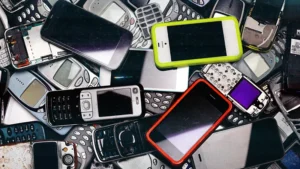A Reaction to the Oversaturation of Smartphones: The Ascent of Dumbphones
The Rising Demand for Dumbphones: Many people who identify as neo-Luddites, a term used to describe those who are opposed to or skeptical of new technologies, or suffer from digital stress are opting for simpler phones in a world where feature-rich smartphones are the norm. According to industry experts, catering to this niche demand is challenging due to small profit margins and an unstable market.

Serenity Strull/BBC/Getty Images
A Concise Overview of the Smartphone Age
This year marks the 17th anniversary of the iPhone, which changed how people use technology forever. The arrival of the touchscreen-controlled gadget has influenced our expectations about smartphones. For almost a generation, people have learned about the pros and cons of cell phones through personal experience and scientific research, never having to imagine a future without them.
The Unseen Expenses of Networking
Nowadays, many people know complete well what the downsides of always being connected are. Despite all its benefits, smartphones have the potential to harm one’s mental health, sleep quality, and ability to concentrate. While there are apps that can help reduce screen time and its associated problems, some people are choosing a more extreme approach: going back to using “dumbphones.” Avoiding the plethora of capabilities seen on contemporary smartphones, these entry-level phones focus on the basics: making calls, sending texts, and setting alarms.
A Marketplace for Ease
Dumbphones, such as the CAT-S22 flip phone, offer a wide range of potential buyers. Parents looking to restrict their children’s screen time, older adults who prefer uncomplicated devices, and people who operate in rough conditions and require long-lasting tools are all potential customers. Additionally, for those watching their pennies, dumbphones are a great alternative to pricey smartphones. For instance, the CAT-S22 flip phone, a combination of intelligent and dumb characteristics with access to basic apps like Google Maps, is available for $ 69.99.
Making the Switch to Dumbphones: A Difficult Journey
In contrast to the mountain of smartphone reviews, finding the right dumbphone can be an unexpected challenge owing to a lack of options and advice. To assist consumers in making an informed purchase, Joe Briones, a writer and vocal proponent of dumbphones, has created a ‘dumbphone finder’ tool. This tool helps users identify the best dumbphone for their needs based on factors such as price, features, and user reviews. For example, for $69.99, you can get the CAT-S22 flip phone, a combination of intelligent and dumb characteristics with access to basic apps like Google Maps.
Dumbphones’ Impact on the Economy
Dumbphones are in high demand, yet they are only sometimes financially viable. Dumbphones, of which feature phones are a subset, account for a negligible portion of sales. August 2023 saw 2.8 million feature phones sold in the US, notwithstanding their small percentage of the total. The simplicity and price of these phones keep them popular, but makers don’t make much money off of them.
Big Tech’s Hesitation
Tech companies make a ton of money off of premium smartphones and other products, so they don’t really need to invest in dumbphones. It would be financially foolish for these corporations to put resources into creating and promoting dumbphones because feature phones are so much less profitable. In order to maximize profits, companies with multiple revenue streams, such as Samsung’s semiconductor division, focus on the ones that bring in the most money.
Where Do Dumbphones Go From Here?
While the future of ‘dumbphones‘ remains uncertain, their resilience and adaptability in the face of technological advancements is a reassuring sign. Although many ‘dumbphones’ are losing support for older networks, they continue to cater to a niche market. However, the increasing importance of smartphones with app capabilities in contemporary workplaces does pose a challenge in terms of expanding their pool of prospective buyers.
Niche markets, though, are real. The Light Phone, made by the New York-based firm Light, is one example of a minimalist gadget, a term used to describe a device that offers only the most basic features and functions, that aims to lessen the impact of digital distractions without sacrificing necessary features. Customers looking for a high-end, purposeful phone can get one for $299. Similarly, Punkt, a Swiss manufacturer, unveiled a stripped-down smartphone for $750, aiming it at affluent buyers who value form over function.
Fresh Solutions
Ghost Mode and other innovative ways provide an additional option. Ghost Mode, a program that isn’t selling a new phone, but rather reprogramming current ones, such as the Google Pixel 6a, to lock them into a basic mode that the user specifies. This program offers an attractive alternative for individuals who wish to cut back on smartphone use without giving up all modern technology altogether, albeit a pricey one at $600.
First-Held Thoughts on Dumbphones
The decision to switch to ‘dumbphones’ can lead to personal growth and improved well-being, as evidenced by numerous first-hand accounts. For instance, many individuals reported enhanced focus and overall health after transitioning from an iPhone to the CAT-S22 flip phone. Despite the occasional need for specific applications, such as a library app, the availability of tweaks like the Minimalist Phone app, which simplifies the UI and restricts non-essential apps, offers a promising solution.
In summary
Dumbphones are making a comeback because people want to limit their exposure to harmful technologies and reduce the bad effects of smartphones. Despite the modest size and economic difficulties of the market for these devices, there seems to be a continuing, albeit niche, interest in their simplicity and reduced connectivity. Dumbphones and minimalist alternatives will certainly change with the times, providing a variety of options for people who want to escape the constant barrage of digital media.








































Comment Template